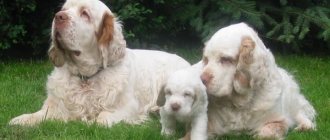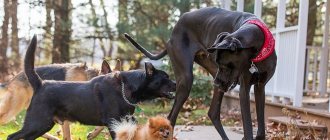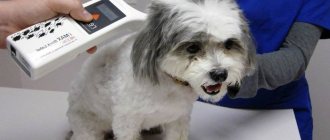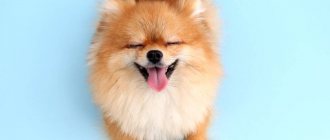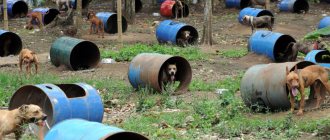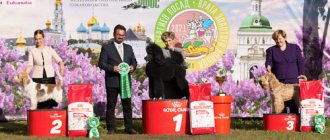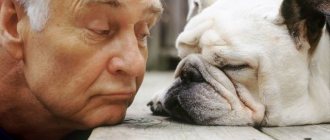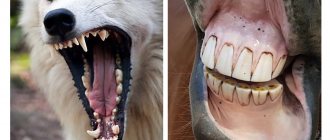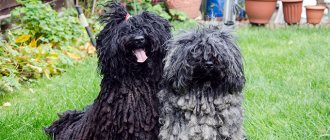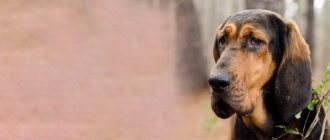The classification of RKF breeds is necessary in order to systematize their diversity. Special commissions determine the standards that dogs must meet. Based on this data, breeders create pedigrees. Today there are a large number of similar classifications with their own criteria.
Purebred pets participate in exhibitions
Basic taxonomies of dog breeds
When thinking about a pet, future owners focus on certain characteristics. They usually relate to appearance - size, color and specialization. By specialization, cynologists mean the predominance of specific dog qualities:
- decorative ones have a beautiful appearance, but are not intended for home protection or hunting;
- watchdogs protect the owner and family members, property, and other animals. They are distinguished by their loud barking;
- employees take part in various operations or help a person with disabilities;
- hunting breeds have always been highly valued in society;
- shepherds guard livestock and help shepherds;
- sled dogs were mainly bred in the northern regions;
- “companions” - such dogs always accompany a person and are sociable. Often act as a nanny or caregiver;
- fighting breeds are no longer used for their intended purpose. More often they are repurposed as “companions” or service ones. But on walks they still need a muzzle.
This is a common FCI classification that is most often used when choosing a pet. But there is another one - according to the type of wool:
- naked;
- with smooth hair;
- with long hair;
- with short hair;
- wire-haired;
- fluffy.
People with allergies and who are not willing to spend time caring for dog hair choose hairless, smooth or short-haired ones.
If the pet’s appearance is important to the owner, then you can get a dog with long hair or a fluffy one. Important! Even “hairless” breeds have fur, which also needs care.
And there are hypoallergenic dogs among other breeds. The third criterion for classifying FSI dogs is size:
- dwarf;
- small;
- average;
- large;
- gigantic.
The breeder is obliged to provide all documents confirming that the dog meets certain FSI breed criteria. Sometimes dog handlers specifically cross certain varieties. In this case, the buyer is shown papers confirming the purebred parents.
The dog must meet the standards
Review
Classification of hunting dogs
When choosing dogs for hunting together with a person, you need to understand that dogs differ in the way they obtain prey.
Therefore, they were divided into the following groups and received corresponding names:
- Hounds - these dogs find game and follow it, giving a signal to the owner with their loud bark. The most famous of this group are the Estonian hounds.
- Blood Hounds - These dogs can track prey even hours after being shot. This is due to their incredibly sensitive sense of smell and good endurance. The most popular among them are the Bavarian mountain hounds.
- Greyhounds - dogs from this group not only drive game, but also strangle it, driving it out into the open. A popular representative of this group is the Deerhound.
- Coppers - these dogs detect the scent of prey through the air. Confirmation that they have caught the scent is their stance. Receiving the hunter's command, the dog scares away the prey and the man fires a shot. The most popular representative of this group is the German Shorthaired Pointer.
- Spaniels look for birds, scare them away, after which the hunter fires a shot. Upon receiving a command, the Spaniel breed of dog grabs the shot bird and brings it to its owner.
- Burrowers are a breed of dogs such as dachshunds and terriers that hunt prey directly in the hole, driving it deeper or, conversely, driving it out of the hole under the hunter’s gun.
- Retrievers - these dogs must find and bring back prey shot by a hunter.
REFERENCE! In fact, hunting dogs can do any job just as well, but all of them are distinguished by such qualities as quick intelligence, good endurance and the ability to concentrate.
Sports and service dogs
Representatives of this group of dogs are engaged in the protection of important objects, participate in the investigation of criminal cases, and drive livestock. They are distinguished by good endurance and a sharp, quick-thinking mind.
Classification of service dogs by purpose:
- Detectives - participate in the search and capture of criminals. In addition, representatives of this group successfully find narcotic or explosive substances, as well as corpses. The best detection dogs are shepherds.
- Guard dogs are divided into bodyguards and watchmen. Bodyguard dogs protect people; these include mainly Rottweilers and Dobermans. Guard dogs protect certain objects (private houses, factories, warehouses, etc.), the most popular are Alabais.
- Herding dogs - as the name of the group implies, these dogs are engaged in monitoring livestock so that they do not wander around the field. In addition, they are capable of driving livestock. Terriers are the best shepherds.
- Sled dogs - representatives of this group are used to transport people and cargo. This group mainly includes malamutes and huskies.
- Rescuers - these dogs are designed to save people. They can dive after a person into the water and pull him out, and can also find freezing climbers even under a layer of snow in the mountains. The best representatives of this group include Newfoundlands and St. Bernards.
REFERENCE! Despite this division, absolutely all dogs are friends for humans and do everything only for their sake. Therefore, dog qualities such as affection and love for humans, awareness and the ability to serve help them and us to be able to use dogs in many areas of our lives.
Decorative dogs
Dogs of decorative breeds are adapted for life only in an apartment or house. They are very attractive and elegant, they need to be taken care of, carefully caring for their fur, making haircuts and the like.
They have a spoiled character. They can be described as a toy - they are very funny and can almost always distract and entertain their owner. This description is especially suitable for small decorative dogs.
Decorative dogs include all types of dogs that are not capable of performing any tasks assigned to them. This group includes large, medium and small dog breeds. Among the representatives of this group you can often find dogs that were bred for hunting, but in the modern world they are purely domestic animals.
Most dogs of decorative breeds often take part in various exhibitions. Representatives of this group compete in appearance and ability to carry out the owner’s commands.
When choosing a dog, it is very difficult to choose a particular breed. Before buying a puppy, you need to start analyzing your life, its level of activity and the conditions that you can give to the future dog, and then you can choose the breed that is right for you.
Legend
The Russian Canine Federation (RKF) has adopted the following symbols for breed groups of dogs:
- Category 1 - herding and cattle breeding;
- 2 - pinschers, schnauzers, molossians, mountain dogs and Swiss cattle dogs;
- Group 3 - terriers;
- 4 - dachshunds;
- 5 - Spitz and primitive type breeds;
- 6 - hounds and related breeds;
- 7 - cops;
- 8 - retrievers, spaniels and water dogs;
- 9 – group of decorative and “companion” dogs;
- 10 - greyhounds.
There are other designations that are used in federations of other countries. Russian breeders rely on the RKF and FCI dog breed standards.
Membership in the IFF
Members of the FCI are cynological organizations of any country, one organization from each country. If several organizations from one country apply for membership in the FCI, the FCI selects the organization that is the most significant among them. To this end, the FCI is conducting a preliminary study of the situation in this country, for which it is sending a representative there. The FCI may include:
- FULL MEMBERS
- ASSOCIATE MEMBERS,
- CONTRACT PARTNERS.
Any national canine organization (Kennel Club of the country) must meet several mandatory conditions in order for the issue of its membership to be fundamentally considered:
1. The Kennel Club should unite lovers of all breeds recognized by the FCI (currently 337 breeds are registered).
2. The Kennel Club must maintain a single pedigree book for all cultivated dog breeds.
3. The Kennel Club is responsible for the production of pedigrees and their accuracy.
4. The Kennel Club is responsible for the preparation and qualification of experts in accordance with international requirements.
5. The Kennel Club guarantees compliance with the basic rules and regulations of the FCI, as well as FCI standards for all recognized dog breeds.
6. The Kennel Club undertakes to conduct International exhibitions and competitions according to FCI rules.
7. The Kennel Club must be officially registered in its country.
Valid FCI membership is currently preceded by a contractual partnership and subsequent associate membership. The relations between contractual partners and the FCI, as well as the relations between associate members and the FCI, are governed by special Agreements. These Agreements cover issues of mutual recognition of stud books, pedigrees, experts, nursery names, as well as certain additional responsibilities and restrictions. Agreements for associate members and contractual partners differ only in the number and type of restrictions.
Thus, CONTRACTUAL partners do not take part in voting at meetings of the General Assembly and sectional meetings. They pay FCI for export pedigrees at a fixed rate; in these countries the number of International experts, the number of International exhibitions and competitions are limited. In addition, experts from a “contractual partner” country can judge a limited number of breeds at foreign exhibitions of the International rank and cannot judge FCI and Best in Show groups.
ASSOCIATE members have all rights except the right to vote at meetings of the General Assembly and the right to be elected to the governing bodies of the FCI (General Committee and Commissions). In addition, the number of International Experts for all breeds and groups is limited by the current Agreement.
An Associate Member may, by decision of the General Assembly, become a FULL MEMBER upon application in advance if at least 7,000 dogs have been registered in the applicant country's database during the previous year.
Representatives of full member countries of the FCI have the right to vote at meetings of all governing bodies of the FCI and be elected to their composition. Restrictions on the number and rank of experts, as well as on the number of International Exhibitions, do not apply to these countries.
The FCI is now a worldwide organization. However, England, America and Canada do not have their representatives in the FCI. This is due to the fact that the Kennel Clubs of these countries were created long before the formation of the FCI. Thus, the oldest Kennel Club is the Kennel Club of Great Britain (1873). A little “younger” are the American Kennel Club and the Canadian Kennel Club. During their existence in the period before the formation of the FCI, these organizations managed to create their own specific rules in the field of dog breeding, and most importantly, they adopted their standards for cultivated dog breeds, which differ significantly from the standards of the countries of origin of these breeds and, therefore, from the FCI standards. This circumstance is the main obstacle to the entry of these countries into the FCI system, where the basic principle regarding breed standards is different - the norms of any standard are initially determined by the country - the homeland of a given breed, or the country in which the breed in question received its development. However, negotiations are currently underway between the FCI and the above countries to overcome existing contradictions and find consensus.
Classification of dog breeds recognized by the Fédération Cynologique Internationale (FCI)
There are branches of this organization in 98 countries, including Russia. The areas of work of the IFF are as follows:
- processing and analysis of the results of international exhibitions where world-class titles are awarded;
- confirmation of the results of the International Championship;
- updating old criteria for breeds and translating documents into foreign languages;
- selection of judges to work at exhibitions;
- study and development of international documents;
- selection of dates for exhibitions and other important events.
Important! Some countries have breeds that are not included in the FCI classifications. In this case, one should rely on the ICF standards.
Conditionally recognized breeds
RKF dog breeds that are not recognized internationally:
- Australian Shepherd;
- white Swiss shepherd;
- Polish hound;
- Dogo Canario;
- Taiwanese dog;
- Australian short-tailed cowtail;
- Romanian Shepherd.
These breeds have not received official recognition from the FCI, but are included in the standards of the Federations of other countries. Their representatives may not be allowed to participate in serious international competitions - it all depends on the decision of the commission. Such animals can take part in less significant exhibitions.
Polish hound
Unrecognized breeds
They are not recognized in all branches of the Canine Federation. This is usually the result of crossing other breeds or mixed breeds. This group includes:
- American Bulldog, Hairless Terrier and Pit Bull Terrier;
- Afghan aboriginal hound;
- Biewer Yorkie;
- Boerboel;
- East European Shepherd;
- Canadian Eskimo;
- Moscow watchdog;
- Prague rat rat;
- Serbian protective;
- Moscow dragon;
- basins;
- short greyhound;
- colored lapdog.
The listed breeds may be recognized in one country, but they are not allowed to compete in competitions organized by the FCI and cannot win a championship title.
Existing types of classifications
The canine organization FCI (Federation Cynologique Internationale), or FCI (International Canine Federation), is responsible for the development of uniform international standards. It consists of 98 member countries, including Russia. It also performs other important tasks:
- regularly updates approved standards;
- coordinates international dog shows and processes their results;
- confirms championship titles and selects the judges who award them;
- develops all international documents related to the protection and popularization of cynology.
FCI was created in 1911, so it cannot be called the oldest. Until this point, classification was carried out in England, the USA and Canada, but strictly at the national level.
The largest organizations in these countries include the following:
- ACC (English Kennel Club)
. The oldest canine organization, founded in 1873 to develop uniform rules for dog shows and field trials. Actively involved in charity work.
- AKC (American Kennel Club)
. Founded in 1884 for the breeding of purebred animals. Unlike ACC, AKC pays more attention to the purity of the pedigree, rather than upbringing and training.
- KKS (Canadian Kennel Club)
. Registered in 1888 to maintain registers of canine pedigrees and protect the interests of owners of four-legged dogs. Imposes a strict ban on the breeding, purchase and sale of unrecognized breeds.
In Russia, similar issues are dealt with by the RKF, or Russian Cynological Federation. It received official registration only in 1996 and is the youngest representative among the listed organizations. Despite the fact that ACC, AKC and KKS are not part of the FCI, the RKF recognizes the breeds approved by them.
Cynological federations and clubs are, of course, very important, but when choosing a future pet, many owners take into account not purebred. Most often, the first place is given to the features of maintenance and care that suit the lifestyle and size of the apartment.
If breeding and participation in exhibitions do not play a big role, then before purchasing a four-legged family member, you should take a closer look at 3 more classifications, taking into account the purpose, weight and type of coat.
American Kennel Club
This is a non-profit society that maintains a registry of purebred dogs. The club holds a number of events each year where four-legged participants and their owners can receive honorary titles. The American Kennel Club identifies 7 main groups:
- hunting and gun-related;
- hunting;
- official;
- terriers;
- indoor decorative;
- not hunting;
- shepherds
The American Club has a separate document in which data on the pedigree and litters of animals is entered. These marks apply only to new breeds and are needed for their official registration.
Terrier dog
Pets for allergy sufferers
For people suffering from asthma and other similar reactions, hypoallergenic breeds are suitable, for example: Mexican Hairless Dog, Maltese, American Hairless Terrier. All animals for allergy sufferers should not shed much or at all, or should be hairless . Pets that produce excessive saliva are excluded from this list. Smooth-coated species have fine guard hair, which irritates the mucous membranes much more than the hard coat of schnauzers and the like.
If you find an error, please select a piece of text and press Ctrl+Enter.
English Kennel Club
Its other name is the Kennel Club. He is engaged in the registration of representatives of purebred breeds. The organization distinguishes the following categories:
- hunting;
- guns;
- terriers;
- custom;
- official;
- indoor decorative;
- shepherds
Important! In the UK, a law has been passed requiring pets to be microchipped. Without this, the dog will not be included in the English Kennel Club register.
Herding and cattle dogs, except Swiss cattle dogs
This group is officially recognized by the FCI. The name of the breed was given by the name of the area in which they were bred. Their distinctive feature is a developed herding instinct, which is inherited. The main purpose of dogs is to guard the herd. They have a strong physique, a phlegmatic character and a large supply of patience.
Continental Cops
This breed is distinguished by its ability to “stand” in front of the animals they hunt. Continental Pointers help hunt birds and small game.
Short-haired pointers or "brakk"
Germany is considered the homeland of these dogs, and their breeding took place under the control of professional hunters. Brakki are able to cope with any task on the hunt. But this breed is not suitable for apartment living, since pets need space and a lot of physical activity.
Spaniel
This is a hunting breed, whose representatives are capable of catching medium-sized animals. But they are useful exclusively for land hunting. Spaniels are distinguished by their intelligence, intelligence, and energy. But now this breed has long been domesticated and is not used for hunting.
Purebred spaniel
Division by specialization
Another accounting system divides dog breeds into 8 types, depending on their specialization. This feature is important for future owners to soberly assess their capabilities for maintenance and upbringing.
Hunting
Bloodhounds, Weimaraners, Afghan hounds, Russian greyhounds and Italian Greyhounds have been helping humans in hunting wild animals for a long time. They are united by courage, agility, speed and endurance.
“
Top 27 hunting dogs
Service
Cane Corso Italianos, Newfoundlands, Dobermans, Giant Schnauzers and St. Bernards work in the police, help the blind and participate in search and rescue operations. It takes a lot of time and effort to raise them, so it is not recommended for workaholics to have such dogs.
Sentinels
Guard dogs have good hearing and sense of smell. The trust of Moscow watchdogs, Caucasian shepherd dogs, German pinschers, bullmastiffs and Schipperkes is very difficult to earn, which is very important for protecting the house from intruders.
“ Top 30 dogs for protection
Shepherd's
Welsh Corgis, Komondors, Shelties, Scottish and Australian Shepherds are strong and resilient. They have strong immunity and thick hair, making it easier to work in all weather conditions. All these smart and obedient animals still continue to help shepherds in grazing and protecting the herd.
“ Top 15 Herding Dogs
Riding
The Chukchi Sled Dog, Chinook, Husky, West Siberian Laika and Alaskan Malamute are practically immune to frost and wind. Despite their massiveness, they easily move through the snow, even with a load. For this reason, they have long been used to transport things and people in the Far North.
“ Top 5 sled dogs
Fighting
Ca-de-bo, gampra, English mastiff, Rottweiler and Dogue de Bordeaux have a common origin: the animals were bred to participate in brutal dog fights, but thanks to the intervention of animal rights activists, this “fun” was abandoned. With proper training, they can be raised into very loyal and friendly pets who love children.
“ Top 20 fighting dog breeds
Decorative
Maltipoos, Papillons, Pekingese, Prague Rat Dogs and Russian Toy Terriers are united by their miniature size. They are suitable for apartment living, do not require long walks and quickly learn to go to the litter box.
“ Top 30 small dog breeds
Companions
Labrador Retrievers, Cavalier King Charles Spaniels, Poodles, Dalmatians and American Spaniels are often purchased as pets. They are united by complaisance, a balanced psyche and boundless love for people. Such animals are popular among the elderly and disabled people who need a faithful four-legged friend.
Schnauzer
This breed is further divided into three mini-groups:
- miniature schnauzer;
- miniature schnauzer;
- Giant Schnauzer.
Representatives of these breeds have a square build, a massive head, a “beard” and large eyebrows. Schnauzers are wire-haired dogs. They are highly intelligent and easy to train. They make excellent watchdogs and comrades.
Important! Schnauzers love to spend a lot of time outdoors, so they are worth getting for those who lead an active lifestyle.
Big dogs
Large breeds are suitable for being kept outside. There are exceptions if they are smooth-haired and sedentary creatures. Among the giant dogs are vigilant guards (they can protect objects as well as people), diligent shepherds and hardy, dexterous hunters. It is believed that representatives of large breeds have a stable psyche: they do not react to minor stimuli and have a good-natured disposition. Surprisingly, large individuals eat relatively little and are often unpretentious in terms of care.
If you are attracted to large dog breeds, keep in mind: they tend to be overly independent and can be uncontrollable if poorly trained. Calculate your strength: it’s not easy to restrain a huge dog on a walk if he decides to rush after a passing cat. Among the disadvantages of large breeds: an abundance of hair and drool, if we are talking about brachycephals. The most popular breeds are the following: Great Dane and German Shepherd, St. Bernard, Alabai, Irish Wolfhound, Cane Corso, Tibetan Mastiff, Golden Retriever.
Pinschers and Schnauzers, Molossians and Swiss Mountain and Cattle Dogs
These animals were combined into one group due to similar features. Their structure and appearance meet all international standards. Dogs are loyal to their owner, have high intelligence and can perform various functions.
Rocks
They are one of the varieties of Molossians. They make excellent watchmen and shepherds. These are large dogs with thick and dense hair, strong immunity.
A dog from a group of pinschers
Molossians
Molossians include:
- herding dogs;
- mastiff dogs;
- herd dogs.
Their main characteristics are powerful, muscular bodies and equally powerful jaws. They are incredibly hardy and have high immunity.
Attention! Molossians are difficult to train dogs that are willful and disobedient. Despite all this, they are very smart. Training should begin from puppyhood.
South African Boerboel
What groups are dogs divided into based on appearance and use?
Several classifications have been developed; dogs are distinguished by use:
- sentinels;
- shepherds;
- companions;
- hunting;
- workers;
- decorative.
Exterior classification is one of the most difficult to define. Some dog handlers connect the appearance and character of a dog. Each country has its own classification based on appearance, which can be used as a guide when choosing a pet.
The Canine Federation makes all important decisions
Classification by size
There is a division of dogs by size. The pet's height is measured at the withers:
- miniature - up to 30 cm, and weight - up to 4 kg;
- small - up to 40 cm, weight - up to 10 kg;
- medium-sized - up to 40-55 cm, weight - up to 25 kg;
- large - up to 55-75 cm, weight - 26-50 kg;
- giant - height exceeds 75 cm, weight more than 50 kg.
The larger the dog, the more difficult it will be for it to adapt to living conditions in an apartment. But miniature ones also require a lot of care and special conditions.
Comparative classification
Breeds are compared with each other according to the following criteria:
- activity on the street and at home;
- obedience to one's own and to others;
- dominance over people and other pets;
- protecting your territory from people and other animals;
- sociability;
- concentration of attention;
- manifestation of aggression;
- behavior with other family members;
- attitude towards children;
- official use.
This technique is used to evaluate a group of FCI dogs. It clearly shows which qualities the dog has best developed. Thanks to this, you can choose a pet that matches your personality.
There are uniform standards recognized by the IFF. But different branches have their own classifications. When purchasing a puppy, the breeder is required to provide documents confirming its compliance with the FCI breed criteria. Understanding the main features will help predict the dog's future development.
Breeding dogs
Breeding work is understood as a system of activities that are aimed at improving existing breeds, breeding new breeds and creating effective commercial livestock. The cessation of breeding work under human control over several generations leads to the transformation of the livestock into a group of outbred animals that have lost all the characteristics of the original breed.
The main elements of dog breeding are selection, selection and targeted rearing of young animals. All three main breeding methods are used in dog breeding: purebred breeding, crossing and hybridization.
Selection
The most valuable representatives of the breed are selected for breeding. Breeding value is manifested in the ability of an individual or group of individuals to produce offspring of a certain quality when mating with a particular group of individuals. The value is determined based on an assessment of the dog’s own phenotype, the genotype and phenotype of its ancestors, relatives and descendants.
Bitch with suckling puppies
When assessing breeding value, the following are taken into account:
- exterior and constitution;
- growth and development;
- working qualities and behavioral characteristics;
- reproductive abilities;
- resistance to diseases.
In dog breeding, mass (based on one's own phenotype) and individual (based on genotype) selection are used, however, due to the low heritability of most traits for which selection is carried out, individual selection is more effective and is widely used in world practice.
Selection
Breeding selection is a zootechnical technique that allows systematic improvement of representatives of the breed. In homogeneous selection, to enhance and consolidate the desired characteristics, a male and a female are selected that are similar in appearance, working qualities, and sometimes in origin. Heterogeneous selection (outbreeding) involves obtaining offspring from parents that differ in a number of characteristics. It is believed that a heterogeneous selection can eliminate the manufacturer’s shortcomings. Both forms of selection are used together.
When selecting individuals for mating, the degree of relatedness of the producers is of particular importance. In dog breeding, related mating (inbreeding) is widely used, which makes it possible to consolidate the desired characteristics. However, the continued use of close inbreeding also increases the risk of genetic diseases. Conscientious breeders are now testing their sires for carriers of hereditary diseases.
Purebred breeding
Portrait of a Smooth Fox Terrier
The task of purebred breeding is to preserve the biological and economic characteristics of the breed, created by previous breeding work, and improve them in the chosen direction.
The basis of purebred breeding is considered to be line breeding in the form of optimal use of evaluated sires. There are genealogical and factory lines. A genealogical line can be formed without special breeding work, in the form of a group of animals descended from one common ancestor. The factory line is characterized not only by a common origin, but also by a number of common characteristics that are supported by breeding work. Line breeding makes it possible to avoid accidental inbreeding. The creation of a breeding line consists of selecting the ancestor, creating a sufficiently large related group, typing based on a comprehensive assessment of the livestock, consolidating the type through intraline selection using inbreeding, enriching the line by adding blood from other lines.
Crossbreeding
Interbreeding in dog breeding is carried out using different methods, depending on the purpose.
Industrial crossing is used to produce individuals that are able to work in special conditions or have higher working qualities, for example, the ability to train.
Introductory crossbreeding (infusion of blood) is used in cases where there is a need for a deficiency in an already established breed, as well as if it is necessary to increase the genetic diversity in the breed. The producer of the improving breed is used in breeding once.
Absorption (or transformative) crossing is used to radically improve one breed with the help of another, when the original breed does not meet the requirements for it, but cannot be immediately and completely replaced by another breed.
Reproductive crossbreeding aims to produce new breeds that combine the valuable properties of the original ones.
